 | | The Grove box. |  | 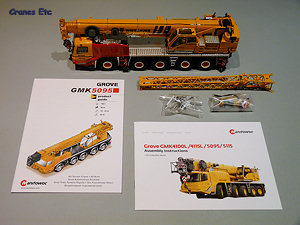 | | The parts out of the box. The main counterweight is already attached when the model is shipped. | 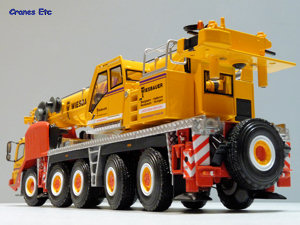 | | Rear view. | 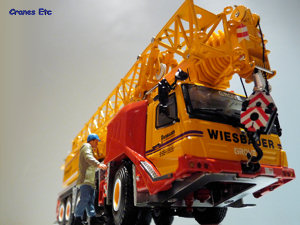 | | Excellent driving cab. | 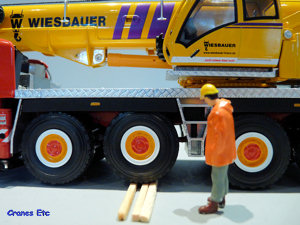 | | Working suspension. | 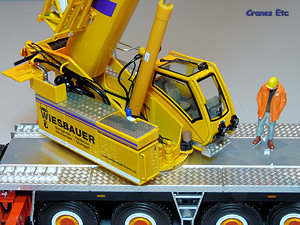 | | Super detailing on the crane. | 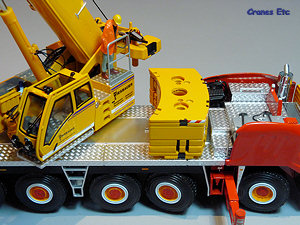 | | The ballast sits well on the carrier. | 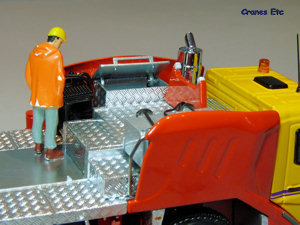 | | Opening equipment chest. | 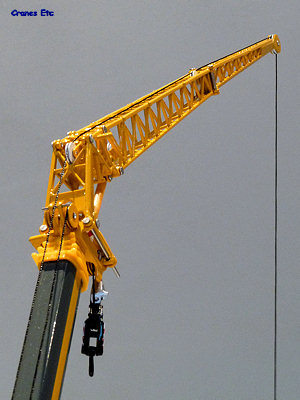 | | Fly jib attached and posed at an offset. | 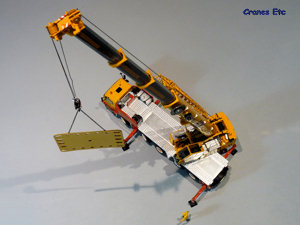 | | An impressive model. |
| The Grove GMK 5095 is a five axle crane rated at 100 tonne (115 US ton) capacity. It has a 60m main boom, with up to 22m of fly jib and can be fitted with 27 tonnes of counterweight. In the US the crane is designated the GMK 5115.
The review model is in the colours of Wiesbauer which is a family owned German crane and heavy haulage company founded in 1958.
Packaging
This model comes in a Grove style box which has a photo of the crane and some dimensioned line drawings. Inside, the model is well packed in expanded polystyrene trays with some additional soft packing. The review model had no defects or missing parts.
The model comes with a small version of the Grove product guide which has plenty of information on the real crane. Also included is a ten page booklet of assembly instructions which is shared with the GMK 4100L model. These instructions are a model example of how good instructions should be presented. The instructions are in English only and assembling the parts is not difficult. Out of the box the model is already reeved so this saves work for the collector.
Detail
Underneath, the chassis is very detailed with excellent metal transmission and axles, and a full set of replica hoses to each wheel. Engine details are also present. The wheels are a little different to earlier Grove models in that the tyres have a different feel to them and they are mounted on plastic hubs.
The outrigger beams and pads are metal although the beams themselves are single castings and so do not replicate the two stage nature of the real outriggers. In part this modelling decision results in the extension of the outriggers being proportionately significantly less than those on the real the crane. On the plus side the details are great, with warning notices and legs which when extended look like pistons instead of screw threads.
At the front, the driving cab is of a high standard. Inside the detail is very good, with clearly visible instruments, a fire extinguisher and some seat belts. On the outside there are some finely crafted mirrors which have to be fitted, including one unusual long one. There are some very nicely detailed steps into the cab which are complete with a patterned surface. A loop for attaching the hook during transport is provided and an orange beacon light and aerial completes the detail on the cab.
The carrier deck has a strong diamond patterned walkway surface and behind the driving cab there is a very fine fuel tank with electric cabling, and a nice exhaust pipe and mesh grating as well as other equipment. At the rear there is a spare tyre, fixed ladders and wheel chocks, and painted light clusters.
Moving to the crane itself, the operator's cab is the same very well executed design as fitted to other recent Grove models, but with an additional mirror on the roof. There is an excellent array of hydraulic hosing which runs to the slewing motors, winches, counterweight attachment mechanism and the main boom luffing cylinder. Behind the cab two separate handrails are provided. One replicates being folded for when the crane is travelling and another for when the crane is working and this approach does allow more accurate modelling in this scale rather than having an out of scale folding mechanism. There is a mirror on the top of the crane body that gives visibility of the winch to the operator but it remains folded in the transport position and cannot be altered.
The counterweight is made up of a series of separate slabs and they each have tabs for lifting chains. The configuration of slabs is a reasonable interpretation of those of the real crane.
The main lift cylinder for the boom is plastic, and the seven section main boom is metal except at the collars which are plastic, and where the colour match is slightly off. The lowest section contains lots of detail within the casting and a couple of spooling drums. One of these is wound with thread to represent cabling although it is non functioning. The boom head sits a little short over the driving cab compared to the real machine and this is a modelling compromise as a result of using castings from previous models. At the boom head there is a block of seven pulleys which is all a single piece so a large multi-line hook would not function smoothly.
The metal lattice fly jib is very nicely made with fine casting and some excellent pulleys. It attaches convincingly for transport although the pins used to secure it to the boom head look too long and skilled collectors will want to trim them back.
Two hook blocks are supplied and they are metal with a single sheave. The tie off point on the hook appears over large for the scale and is a modelling compromise. A single line hook block might have looked better on the fly jib, but even so it is nice to have two hooks.
Features
The suspension on the model is very good and functions with each wheel individually sprung. The steering mechanism links axles 1 and 2, and axles 4 and 5. Axle 3 does not steer, unlike the real crane, so it is not possible to pose crab steering. Also it is not really possible to obtain a hard lock on the steering as tyres start fouling the wheel arches.
The outriggers extend and the pads screw down well and are robust enough to hold the weight of the model. On the carrier deck is an opening equipment chest and this and be used for storing small parts such as pins for the model so this is actually quite useful.
The crane cab tilts to an angle of around 30°. Although not obvious, the counterweight is removable by carefully undoing two screws on the underside and this gives many more display options for the crane including showing a realistic travelling mode, or displaying the crane carrying out self ballasting.
The crane rotates nicely. The boom can be raised and the cylinder is stiff enough to hold a reasonable angle. Boom sections telescope and lock smoothly.
The lattice jib can be pinned into place and three combinations are possible; short, medium and long, with each one able to be set at a variable offset angle using the hydraulic cylinder. On the short jib there is a fold out pulley to correctly run the line to the hook although it does not quite fold out far enough.
The winch works well enough and an optional second winch can be added if desired, or alternatively a separate small counterweight can be attached.
Quality
This is highly detailed model with a little more plastic than has been used on previous TWH Grove cranes although this has generally been successfully employed. The paint and graphics look great in Wiesbauer livery.
Price
The model is good value (based on the manufacturer's retail price) for the quality offered.
Overall
This model looks really good in the Wiesbauer livery and the enhanced detailing makes it a high class piece of modelling. The limited numbers made in special liveries makes it highly collectible. It can be displayed in many ways and it is easy to rate the model as highly recommended.
Footnotes
The model first appeared at dealers in November 2009. Other liveries were produced and were made in the following numbers: Grove yellow - 250
Wiesbauer - 150
Markewitsch - 150
MSG Krandienst - 150
Grove yellow 4115L - 250
|
| |
| 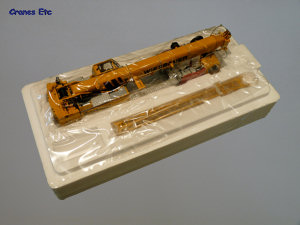 | | The model inside the expanded polystyrene tray. | 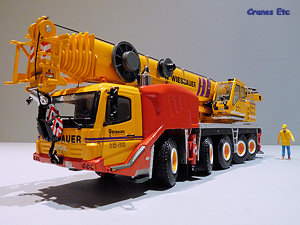 | | Imposing front view. | 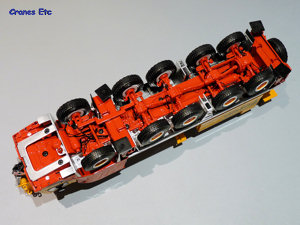 | | Underside is also highly detailed. | 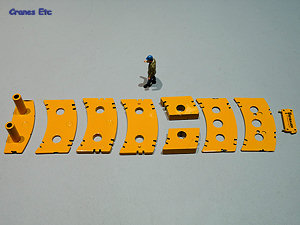 | | Separate ballast slabs. | 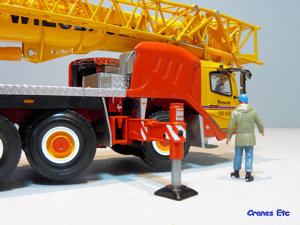 | | Realistic outriggers. | 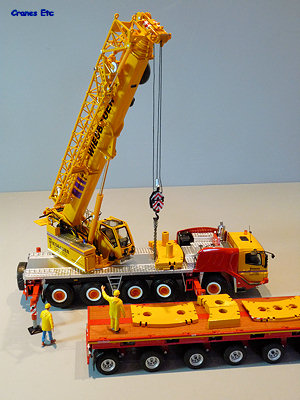 | | Loading up the ballast. | 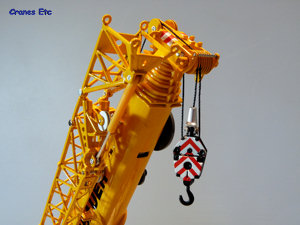 | | Boom head detail. | 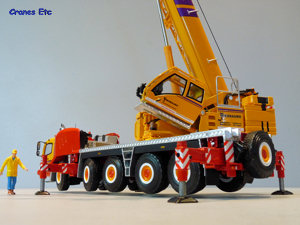 | | The outriggers can support the crane. Cab tilting is impressive. | 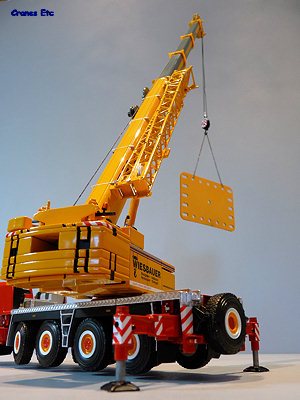 | | Lifting a wall panel. | 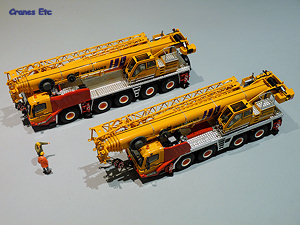 | | Posed with its brother, the GMK4100L. |
|

